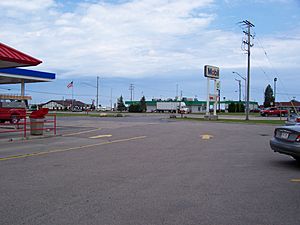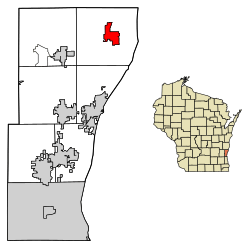Belgium, Wisconsin facts for kids
Quick facts for kids
Belgium, Wisconsin
|
|
|---|---|

Looking east at Belgium's business district
|
|

Location of Belgium in Ozaukee County, Wisconsin.
|
|
| Country | United States |
| State | Wisconsin |
| County | Ozaukee |
| Settled | 1840s |
| Incorporated | 1922 |
| Area | |
| • Total | 2.15 sq mi (5.58 km2) |
| • Land | 2.15 sq mi (5.58 km2) |
| • Water | 0.00 sq mi (0.00 km2) |
| Elevation | 738 ft (225 m) |
| Population
(2020)
|
|
| • Total | 2,245 |
| • Estimate
(2019)
|
2,345 |
| • Density | 1,089.18/sq mi (420.56/km2) |
| Time zone | UTC-6 (Central (CST)) |
| • Summer (DST) | UTC-5 (CDT) |
| Area code(s) | 262 |
| FIPS code | 55-06175 |
| GNIS feature ID | 1582781 |
Belgium is a small village located in Ozaukee County, Wisconsin, in the United States. It sits along Interstate 43 and is one of the northernmost towns in the Milwaukee metropolitan area. In 2020, about 2,245 people lived there.
Starting in the 1840s, many farmers from Luxembourg moved to this area. They created several small farming communities, including Belgium. Other nearby places like Dacada, Holy Cross, and Lake Church were also settled by these immigrants.
Belgium grew when a railroad was built through it. It officially became a village in 1922. For a long time, farming was the main activity. Even in 2015, a local factory that cans fruits and vegetables was the biggest employer.
The village still has strong connections to Luxembourg. Important people from Luxembourg's royal family have visited. The Luxembourg government also supports the Luxembourg American Cultural Society and Museum in Belgium. This center helps Americans with Luxembourg roots learn about their heritage. Since 1987, the village has held a yearly festival to celebrate Luxembourgish food and culture.
Contents
Why is it Called Belgium?
Belgium village has always had many people from Luxembourg. In 1857, these settlers wanted to name their community "Luxembourg." At the same time, a group of Belgian-American settlers in Kewaunee County, Wisconsin wanted to name their town "Belgium."
But there was a mix-up! Due to a mistake, the names were switched. So, Belgium, Wisconsin, became a center for people from Luxembourg. And Luxemburg, Wisconsin, became a center for people from Belgium.
A Look at Belgium's Past
Early Days and Native Americans
The area where Belgium is now, in northeastern Ozaukee County, was once home to several Native American tribes. One of these was the Menominee tribe. In 1832, the Menominee tribe gave this land to the United States government through a special agreement called the Treaty of Washington.
Luxembourgish Settlers Arrive
In the late 1840s, people from Luxembourg began to settle here. In 1848, the area officially became the Town of Belgium, separating from Port Washington.
Growth with the Railroad
The Northwestern Railway Company opened a station in Belgium in 1864. Then, the Chicago, Milwaukee & St. Paul Railway started running trains through the community in 1872. This helped the population grow a lot.
In the early 1900s, Belgium was also a stop on the Milwaukee Interurban Line. This electric train ran between Milwaukee and Sheboygan from 1908 to 1948. More people started living near the railroad station, and Belgium officially became a village in 1922.
World War II and Beyond
During World War II in 1945, about sixty German prisoners of war helped work at a local canning company in the village. This helped make up for the local men who were away fighting in the war.
After World War II, the electric train line stopped running. However, Belgium kept growing. The building of Interstate 43, which connects Milwaukee to Green Bay, helped the village continue to develop.
Connecting with Luxembourg Today
Since 1977, Belgium has been home to the Luxembourg American Cultural Society & Center. This center includes the Roots and Leaves Museum. The museum shares "the story of the Grand Duchy of Luxembourg, past and present." It also shows how Luxembourg immigrants and their families have impacted life in America.
Important visitors from Luxembourg have come to Belgium. In 1987, Prince Henri (who later became the Grand Duke) and Princess Maria Teresa visited the village. In 2016, Hereditary Grand Duke Guillaume and Hereditary Grand Duchess Stéphanie also visited Belgium during their trip to the United States.
Where is Belgium Located?
The Village of Belgium is located at 43°30′2″N 87°50′48″W / 43.50056°N 87.84667°W. It covers about 2.42 square miles (6.27 square kilometers) of land. The village is surrounded by the Town of Belgium. It is also about two miles (3 kilometers) west of Lake Michigan. Interstate 43 and State Highway 32 run right next to it.
Natural Surroundings
Belgium is in an area shaped by glaciers from the last ice age. The Wisconsin Department of Natural Resources considers it part of the Central Lake Michigan Coastal region.
Before settlers arrived, the Belgium area had many forests. These included forests with American beech and sugar maple trees. There were also swampy forests with white cedar and tamarack trees. Much of these original forests were cleared for farming.
As more land is developed, wild animals sometimes come closer to towns like Belgium. You might see large animals such as white-tailed deer, coyotes, and red foxes in the village. The countryside around Belgium also has places where many birds live. Harrington Beach State Park, on Lake Michigan, is one of these important bird areas. It is a breeding ground for upland sandpipers.
Some unwanted plants and insects, called invasive species, are a problem in the region. These include the emerald ash borer, common carp, reed canary grass, and common reed. These species can harm the local environment.
People and Population
| Historical population | |||
|---|---|---|---|
| Census | Pop. | %± | |
| 1930 | 268 | — | |
| 1940 | 356 | 32.8% | |
| 1950 | 460 | 29.2% | |
| 1960 | 643 | 39.8% | |
| 1970 | 809 | 25.8% | |
| 1980 | 892 | 10.3% | |
| 1990 | 928 | 4.0% | |
| 2000 | 1,678 | 80.8% | |
| 2010 | 2,245 | 33.8% | |
| 2019 (est.) | 2,345 | 4.5% | |
| U.S. Decennial Census | |||
Population in 2010
In 2010, Belgium had 2,245 people living in 817 households. Most residents (94.5%) were white. About 5.2% of the population identified as Hispanic or Latino.
Many households (41.9%) had children under 18. Most families (66.0%) were married couples living together. The average household had 2.74 people. The average age in the village was 35 years old. About 29.7% of residents were under 18.
Culture and Traditions
Luxembourgish Heritage
Northern Ozaukee County, including Belgium, was a major settlement area for Luxembourgish Americans in the 1800s. The Village of Belgium still has strong cultural ties to the Grand Duchy of Luxembourg. You might see banners on Main Street that say "Wëllkomm," which means "Welcome" in Luxembourgish.
Since 1977, Belgium has been home to the Luxembourg American Cultural Society & Center. The governments of Luxembourg's Ministry of Culture and Ministry of Economy support this center. It helps Americans with Luxembourgish roots apply for dual citizenship. It also organizes tours to Luxembourg and has a museum about Luxembourg's history and immigration to the U.S. Since 1987, the society has hosted an annual Luxembourg Fest. This festival features traditional foods like träipen.
Churches in Belgium
Many Luxembourgers who settled here were Catholic. They built Catholic churches in the countryside. Small communities like Dacada, Holy Cross, and Lake Church grew around these Catholic churches. The Village of Belgium also has two evangelical churches: Belgium Community Church and Christian Life Church. There is also St. Mark Lutheran Church, which is part of the Missouri Synod.
Local Economy
| Largest Employers in Belgium, 2015 | |||
|---|---|---|---|
| Rank | Employer | Industry | Employees |
| 1 | Lakeside Foods, Inc. | Fruit and vegetable canning | 250-499 |
| 2 | Appleland | Fruit and vegetable wholesaling | 50-99 |
| 3 | Holiday Trims | Christmas tree ornament manufacturing | 50-99 |
| 4 | Trimen Industries, Inc. | Metal coating and engraving | 50-99 |
| 5 | Belgium Gardens | Retirement community | 20-49 |
| 6 | Hobo's Korner Kitchen | Restaurant | 20-49 |
| 7 | McDonald's | Fast food restaurant | 20-49 |
| 8 | Sharon Cutwell Co. Inc. | Cutting tool and machine tool accessory manufacturing | 20-49 |
The table above shows some of the largest employers in Belgium as of 2015. Lakeside Foods, Inc., a company that cans fruits and vegetables, was the biggest employer.
Schools in Belgium
The village is part of the Cedar Grove-Belgium School District. Students attend Cedar Grove-Belgium Elementary School for grades K-4. They go to Cedar Grove-Belgium Middle School for grades 5-8. Then, they attend Cedar Grove-Belgium High School for grades 9-12. All of these schools are located in Cedar Grove, which is north of Belgium. A seven-member elected board of education manages the school district.
Getting Around Belgium
Roads and Highways
Interstate 43 runs along the eastern edge of the village. You can get to Belgium using Exit 107.
Public Transportation
Ozaukee County Transit Services offers a Shared Ride Taxi for residents. These taxis run every day of the week. You need to call ahead to schedule your pick-up time and location. The taxi service plans its routes based on where people need to go.
Trails for Walking and Biking
The Ozaukee Interurban Trail goes through Belgium. This trail is for walking and biking. It connects Belgium to nearby towns like Port Washington and Cedar Grove. The trail also goes north to Oostburg and south to Milwaukee County.
Freight Trains
The Union Pacific Railroad has a freight train line that runs through the village. It runs next to the Ozaukee Interurban Trail. However, Belgium does not have a passenger train station for people to ride trains.
Fun and Recreation
Village Parks
The Village of Belgium has six public parks. These parks offer many things to do. You can find baseball and softball fields, basketball, tennis, and volleyball courts. There is also an ice-skating rink, picnic areas, playgrounds, and soccer fields. Kids can enjoy a splash pad. There is also a three-acre fenced dog park and walking trails.
Grand Duke Henri Plaza
Grand Duke Henri Plaza is located between the village hall and the Luxembourg American Cultural Center. Here, you can find the "Wisconsin's Luxembourgers" State Historical Marker. There is also a statue of Henri, Grand Duke of Luxembourg, who visited the village in 1987.
State Parks and Trails
Harrington Beach State Park is the only Wisconsin State Park in Ozaukee County. It is located just east of the village on the shore of Lake Michigan.
The Ozaukee Interurban Trail also runs through the village. This trail follows the old route of the Milwaukee Interurban Rail Line. It starts in Brown Deer and goes all the way to Oostburg.
Underwater Sanctuary
The Wisconsin Shipwreck Coast National Marine Sanctuary was created in 2021. It protects shipwrecks in the waters of Lake Michigan off the coast of Belgium.
Famous People from Belgium
- Nicholas J. Bichler - A Wisconsin State Representative
- William J. Bichler - A Wisconsin State Senator
- Henry Ellenbecker - A Wisconsin State Representative
See also
 In Spanish: Belgium (Wisconsin) para niños
In Spanish: Belgium (Wisconsin) para niños

